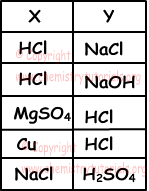Chemical Reactions Exam 1 and Problem Solutions
Chemical Reactions Exam 1 and Problem Solutions
1. Balance following chemical reaction;
C2H5OH + O2 → CO2 + H2O
Solution:
C2H5OH + O2 → CO2+ H2O
We have 2 C atoms in reactants but 1 in products. So, we multiply CO2 with 2 to balance number of C atoms.
C2H5OH + O2 → 2CO2 + H2O
Now we have 6 H atoms in reactants but 2 H atoms in products. To balance them we multiply H2O with 3.
C2H5OH + O2 → 2CO2+ 3H2O
Finally we balance number of O atoms, to balance them we write 3 in front of O2.
C2H5OH + 3O2 → 2CO2 + 3H2O
All atoms are balanced in reactants and products.
2. If given reaction is balanced; find x, y and z numbers in reactants.
CxHy(OH)z + 5O2 → 4CO2 + 5H2O
Solution:
Since reaction is balanced, number of atoms in both sides must be equal.
CxHy(OH)z + 5O2 → 4CO2 + 5H2O
In products we have; 13 O atoms, there must be 13 O atoms in reactants. But we have 10, so “z” must be 3.
In products we have 4 C atoms, to balance it there must be 4 in reactants, so “x"is 4.
C4Hy(OH)3 + 5O2 → 4CO2 + 5H2O
There 10 H atoms in products but 3 in reactants. “y” must be 7 to balance number of H atoms in both sides. Final reaction;
C4H7(OH)3 + 5O2 → 4CO2 + 5H2O
3. Find formula of compound represented with “X” in following balanced reaction.
2I- + 2X + 4H+1 → I2 + 2NO + 2H2O
Solution:
We should check number of atoms in both sides to find formula of X.
There are 2 I atoms in reactants and products, so there is no I atom in X.
There are 4 H atoms in reactants and products, there is no H atom in X.
There are 2N atoms in products but there is no in reactants, so there must be 2 N atoms in reactants.
Since there are 4 O atoms in products there must be 4O atoms in reactants.
X must be “NO2”
2I- + 2NO2 + 4H+1 → I2 + 2NO + 2H2O
Now, we must balance number of charges in both sides.
2I- + 2NO2 + 4H+1 → I2 + 2NO + 2H2O
2.(-1) +2.(x) + 4.(+1) =1.0 + 2.0 + 2.0
-2+2x+4=0
x=-1, so reaction becomes;
2I-+ 2NO2-1 + 4H+1 → I2 + 2NO + 2H2O
and X=NO2-1
4. Which ones of the following reactions are acid-base reaction?
I. N2(g) + 3H2(g) → 2NH3(g)
II. Mg(OH)2(s) + 2HCl(l) → MgCl2(s) + 2H2O(l)
III. CH4(g) + 2O2(g) → CO2(g) + 2H2O(l)
Solution:
I. It is synthesis or formation reaction.
II. Mg(OH)2 is base and HCl is acid.Thus, it is acid base reaction; salt and water are formed.
III. This is combustion reaction.
5. Which one of the following couples can be written into the place of X and Y in reaction below;
X + Y → Salt + H2O

Solution:
X + Y → Salt + H2O is an acid-base reaction. Thus, X and Y must be acid and base or base and acid.
HCl + NaOH → NaCl + H2O
X Y